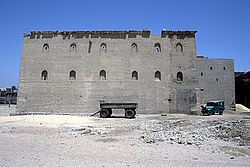Red Monastery
 |
|
| Monastery information | |
|---|---|
| Other names | Deir al-Ahmar or Deir Anba Bishai |
| Established | 4th century |
| Dedicated to | Saint Pishay |
| Diocese | Coptic Orthodox Church of Alexandria |
| People | |
| Founder(s) | Saint Pishay |
| Site | |
| Location | Sohag, Sohag Governorate |
| Country |
|
| Coordinates | 26°33′18″N 31°37′11″E / 26.554931°N 31.619686°E |
| Public access | Yes |
The Red Monastery is a Coptic Orthodox monastery named after an Egyptian saint called Pishay (who is not to be confused with the famous Saint Pishoy). It is located near the Upper Egyptian city of Souhag, and about four kilometres north-west of the White Monastery. The name of the monastery is derived from the color of the construction material of its outside walls, consisting of red (burnt) brick. These walls are considerably thicker at the base than at the top, and, just like the walls of Ancient Egyptian temples, they are surmounted by cavetto moldings. The Red Monastery is architecturally similar to the White Monastery.
The history of the foundation of the Red Monastery is not known, and it is thought to have been built at the fourth century AD. by an Egyptian saint called Pishay (who is not to be confused with the known Saint Pishoy). This saint was a contemporary of Saint Pigol, the founder of the White Monastery.
Almost nothing is known of the history of the Red Monastery (Deir al-Ahmar, Deir Anba Bishoi or Bishai) near Sohag, though it is one of the most famous Christian monasteries in Egypt. It lies about three kilometers north of the White Monastery at the extreme western edge of the cultivated land. However, unlike the White Monastery it is situated within a small village, and some houses lie to the south and east. The area to the north and west of the monastery is mainly covered with debris.
Its name is derived from the color of its construction material, consisting of red (burnt) brick, of its outside walls, which distinguishes it from its nearby neighbor, the White Monastery which is made of stone. These walls are considerably thicker at the base than at the top, and like ancient Pharaonic temples, as well as the White monastery, are surmounted by cavetto moldings. Otherwise, this monastery is architecturally similar to the White Monastery, and most likely its construction dates to the same period (probably the fifth century AD).
...
Wikipedia

